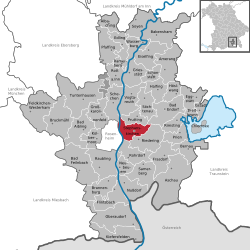Stephanskirchen | |
|---|---|
 Pilgrimage Church of Saint Leonhard | |
Location of Stephanskirchen within Rosenheim district  | |
| Coordinates: 47°51′N12°11′E / 47.850°N 12.183°E | |
| Country | Germany |
| State | Bavaria |
| Admin. region | Oberbayern |
| District | Rosenheim |
| Government | |
| • Mayor (2020–26) | Karl Mair [1] |
| Area | |
• Total | 26.51 km2 (10.24 sq mi) |
| Highest elevation | 502 m (1,647 ft) |
| Lowest elevation | 476 m (1,562 ft) |
| Population (2024-12-31) [2] | |
• Total | 10,558 |
| • Density | 400/km2 (1,000/sq mi) |
| Time zone | UTC+01:00 (CET) |
| • Summer (DST) | UTC+02:00 (CEST) |
| Postal codes | 83071 |
| Dialling codes | 08031, 08036 |
| Vehicle registration | RO |
| Website | www.stephanskirchen.de |
Stephanskirchen (Central Bavarian : Steffeskirch) is a municipality in the district of Rosenheim, Upper Bavaria in Germany.












